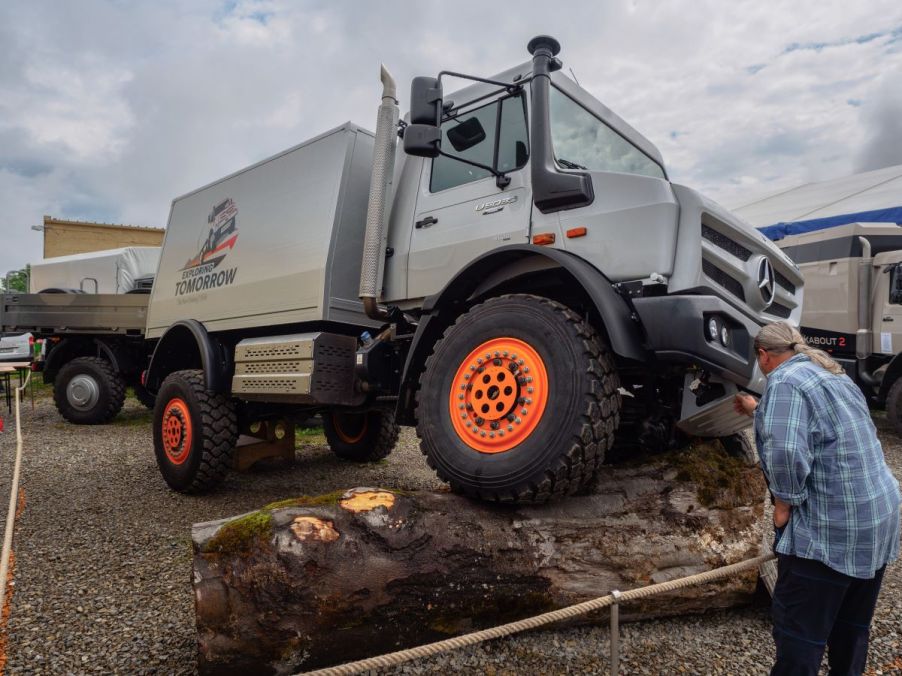
What Was the First Heavy-Duty Mercedes-Benz Unimog?
The Unimog. It looks and sounds like something out of a 1950s dystopian sci-fi movie or a vehicle Arnold Schwarzenegger would drive to Sunday brunch. Or maybe it’s a vehicle Arnold would drive to brunch in a dystopian sci-fi movie. Either way, there’s no mistaking the heavy-duty offroad vehicle that looks like its part tractor and part commercial truck.
However, the original Unimogs were more light-duty vehicles. Built as self-propelled agricultural vehicles, they were designed primarily for offroad use and included features like power connections for an assortment of tools. So, what was the first heavy-duty Mercedes-Benz Unimog? The short answer is the Unimog 425, which was introduced in 1974. Yet it, and the origins of the Unimog, are a story in itself.
A brief history of the Mercedes-Benz Unimog
According to Expedition Meister, Unimog stands for UNIversal-MOtor-Gerat”, with gerat translating from German as a word for device, gadget, or appliance. The first model was created by Boehringer shortly after World War II for agricultural use. Designed with full-time all-wheel drive and very high ground clearance, it was like a tractor with equal-size wheels. The original model was never designed to carry heavy loads or tow large trailers. Instead, it was built to go places other vehicles couldn’t.
In 1951, Mercedes-Benz took over the manufacturing of the Unimog, expanding production and the Unimog lineup. Before long, they started showing up as military vehicles, fire and rescue trucks, and expedition campers. Today they can be found in jungles, deserts, and other remote terrain and are used for farming, plowing snow, and equipment carriers.
The sixth model 425/435 was the first heavy-duty Unimog
Unimog continued making light-duty vehicles for off-road use until 1974, when it branched out with a new line of heavy-duty vehicles. According to Motor1, the sixth model 425/435 was the first heavy-duty Unimog. While certainly capable of offroad use, it excelled as a commercial vehicle.
In all, Mercedes-Benz produced 3,135 425 models with a short wheelbase and over 30,000 long wheelbase versions from 1974 to 1988. Unlike older Unimogs, the 425/435 featured a rigid ladder frame and part-time four-wheel drive. It had a coil suspension and disc brakes on all four wheels. Like the previous models, the heavy-duty Unimog had two shafts to power farm implements but was capable of hauling and towing much heavier loads.
The lone engine was a Mercedes-Benz OM 352 turbo-diesel engine displacing 5.7 liters. Equipped with an eight-speed manual transmission, the top speed was between 50 and 60 mph, depending on the configuration. For heavy off-road and agricultural use, the 425 could be equipped with a planetary gearbox with three gear ranges for regular, field, and crawler use, giving it a maximum of 24 forward gears and three reverse ones.
The modern Unimog provides opportunities that no other vehicle does
Mercedes-Benz still makes the Unimog, marketing it with the tagline, “Continuing on where others have to stop.” The current lineup includes the U4000 and U5000, which are designed for hauling equipment to remote places. Like Unimogs of the past, it’s an extremely capable vehicle that serves many roles.
In Europe and other parts of the world, the Unimog enjoys a cult following. Still, regardless of the location, it continues to serve in many utilitarian roles, including military vehicle, fire truck, troop carrier, ambulance, expedition vehicle, agricultural implement, and as an off-road adventure machine.




